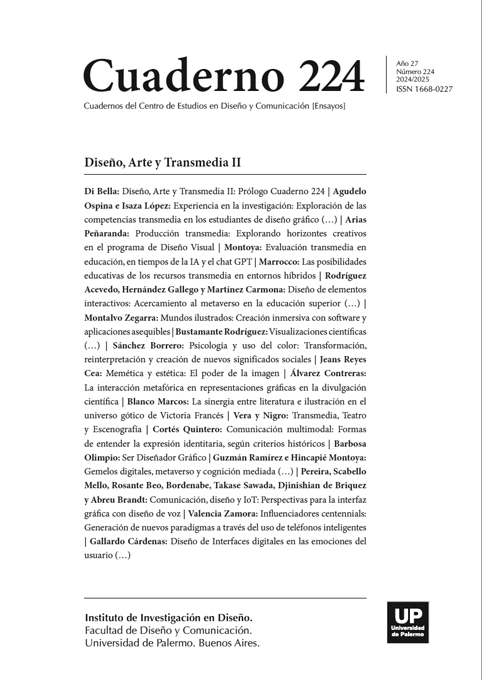Diseño de elementos interactivos: Acercamiento al metaverso en la educación superior en la Institución Universitaria Pascual Bravo, Colombia
Résumé
El contexto educativo actual reconoce la relevancia del diseño orientado a los desarrollos tecnológicos, particularmente enfocados al emergente desarrollo del metaverso.
Références
Amarillo, M. A. O. (2004). Apuntes para una Pedagogia del Diseño. ¿Que Es El Diseño Hoy?, 1–20. https://www.icesi.edu.co/disenohoy/memorias/Ovalle.pdf
Argüello Espinosa, J. M. (2013). El proceso de diseño: diseño interactivo. I+D Revista De Investigaciones, 1(1), 44–52. https://doi.org/10.33304/revinv.v01n1-2013005
Article, R., & Narin, N. G. (2021). A Content Analysis of the Metaverse Articles. Journal of Metaverse, 1(1), 17–24. www.secondlife.com
Barráez-Herrera, D. P. (2022). Metaversos en el Contexto de la Educación Virtual. Revista Tecnológica-Educativa Docentes 2.0, 13(1), 11–19. https://doi.org/10.37843/rted.v13i1.300
Binda, N. U., & Benavent, F. B. (2013, October). buscando las ventajas de las diferentes metodologías. Ciencias Económicas, 31(2), 179–188.
Bowman, N. D., Schultheiss, D., & Schumann, C. (2012). “I’m attached, and I’m a good guy/gal!”: How character attachment influences pro-and anti-social motivations to play massively multiplayer online role-playing games. Cyberpsychology, Behavior, and Social Networking, 15(3), 169–174. https://doi.org/10.1089/cyber.2011.0311
Buddeberg, J., Jenny, B., & Willett, W. (2017). Interactive shearing for terrain visualization: an expert study. GeoInformatica, 21(3), 643–665. https://doi.org/10.1007/s10707-016-0283-9
Carvajal, V. B., & Monge, I. F. (2010). Elementos que favorecen la interactividad en un curso virtual. Innovaciones Educativas, 17, 39–47. https://doi.org/https://doi.org/10.22458/ie.v12i17.562
Cobo Romaní, C., & Pardo Kuklinski, H. (2007). Planeta web 2.0. Flacso México.
Cuartas, S. L. D. (2009). Creación. Un acercamiento a la investigación en las artes. Horiz. Pedagogico, 11(1), 87–92.
Denisova, A., Cairns, P., Guckelsberger, C., & Zendle, D. (2020). Measuring perceived challenge in digital games: Development & validation of the challenge originating from recent gameplay interaction scale (CORGIS). International Journal of Human Computer Studies, 137, 1–15. https://doi.org/10.1016/j.ijhcs.2019.102383
Dionisio, J. D. N., Burns, W. G., & Gilbert, R. (2013). 3D virtual worlds and the metaverse: Current status and future possibilities. ACM Computing Surveys, 45(3), 34–37. https://doi.org/10.1145/2480741.2480751
Fernández, I. M. G., Calvo, A. de C., & Fernández, H. S. (2020). Interacción y uso de tecnologías en los procesos de enseñanza y aprendizaje. Educatio Siglo XXI, 38(1), 119–138. https://doi.org/011-23345$4”6$”783)+$9+)&3:4;<=16”$>)%>>)
Frostling-Henningsson, M. (2009). First-Person Shooter Games as a Way of Connecting to People: “‘Brothers in Blood.’” Cyberpsychology and behavior, 12(5), 557–562. https://doi.org/10.1089=cpb.2008.0345
Ganesh, S., Van Schie, H. T., De Lange, F. P., Thompson, E., & Wigboldus, D. H. J. (2012). How the human brain goes virtual: Distinct cortical regions of the person-processing network are involved in self-identification with virtual agents. Cerebral Cortex, 22(7), 1577–1585. https://doi.org/10.1093/cercor/bhr227
Higuerey, E. (2020). Contenido interactivo: cómo promover una experiencia inolvidable a tus usuarios para fidelizarlos. Rockcontent. https://rockcontent.com/es/blog/contenidointeractivo/
Javier, F., Serrano, T., & Whitman, W. (2005). La virtualización de la sociedad. Athenea Difital, 7, 1–11.
Jeon, J. E. (2021). The Effects of User Experience-Based Design Innovativeness on User– Metaverse Platform Channel Relationships in South Korea. Journal of Distribution Science, 19(11), 81–90. https://doi.org/10.15722/jds.19.11.202111.81
Llobera, J., & Boulic, R. (2019). A tool to design interactive characters based on embodied cognition. IEEE Transactions on Games, 11(4), 311–319. https://doi.org/10.1109/ TCIAIG.2017.2755699
Mon, F. M. E., Segura, J. A., & Cervera, M. G. (2014). Diseño de un entorno 3D para el desarrollo de la competencia digital docente en estudiantes universitarios: usabilidad, adecuación y percepción de utilidad / Design of 3D environment to develop pre-service teachers’ digital competence. Revista Latinoamericana de Tecnología Educativa - RELATEC, 13(2), 35–47. http://mascvuex.unex.es/revistas/index.php/relatec/article/view/1443%5Cnhttp://mascvuex.unex.es/revistas/index.php/relatec/article/download/1443/961
Mujica-Sequera, R. M. (2022). El Metaverso como un Escenario Transcomplejo de la Tecnoeducación. Revista Tecnológica-Educativa Docentes 2.0, 13(1), 20–28. https://doi.org/10.37843/rted.v13i1.268
Navarro, D. S. (2013). Metaverso y artista. BRAC- Barcelona Research Art Creation, 1(2), 130–152. https://doi.org/10.4471/brac.2013.06
Petreca, B., Saito, C., Baurley, S., Atkinson, D., Yu, X., & Bianchi-Berthouze, N. (2019). Radically relational tools: A design framework to explore materials through embodied processes. International Journal of Design, 13(2), 7–20.
Rodríguez García, T. C., & Baños González, M. (2011). E-learning en mundos virtuales 3D. Una experiencia educativa en Second Life. Revista ICONO14. Revista Científica de Comunicación y Tecnologías Emergentes, 9(2), 39. https://doi.org/10.7195/ri14.v9i2.39
Romaní, C. C., & Kuklinski, H. P. (2007). Planeta Web 2.0. Inteligencia colectiva o medios fast food.
Sádaba Chalezquer, M. R. (2000). Interactividad y comunidades virtuales en e entorno de la world wide web. In Comunicación y Sociedad (Vol. 13, Issue 1, pp. 139–166). Comunicación y Sociedad.
Salgado-Levano, A. C. (2007). Investigación cualitativa: diseños, evaluación del rigor metodológico y retos. January. Sampieri, R. H., Fernández-Collado, C., & Lucio, P. B. (2006). Metodología de la investigación. https://doi.org/10.1186/s12885-018-4263-3
Seidel, S., Berente, N., Yepes, G., & Nickerson, J. V. (2022). Designing the Metaverse. Proceedings of the 55th Hawaii International Conference on System Sciences |, 6699–6708. https://hdl.handle.net/10125/80151
Silva-Cañaveral, S. J. (2016). La investigación-creación en el contexto de la formación doctoral en diseño y creación en Colombia. Revista De Investigación, Desarrollo E Innovación, 7(1), 49. https://doi.org/10.19053/20278306.v7.n1.2016.5601
Song, H., Chen, F., Peng, Q., Zhang, J., & Gu, P. (2018). Improvement of user experience using virtual reality in open-architecture product design. Proceedings of the Institution of Mechanical Engineers, Part B: Journal of Engineering Manufacture, 232(13), 2264–2275. https://doi.org/10.1177/0954405417711736
Los autores/as que publiquen en esta revista ceden los derechos de autor y de publicación a "Cuadernos del Centro de Estudios de Diseño y Comunicación", Aceptando el registro de su trabajo bajo una licencia de atribución de Creative Commons, que permite a terceros utilizar lo publicado siempre que de el crédito pertinente a los autores y a esta revista.


